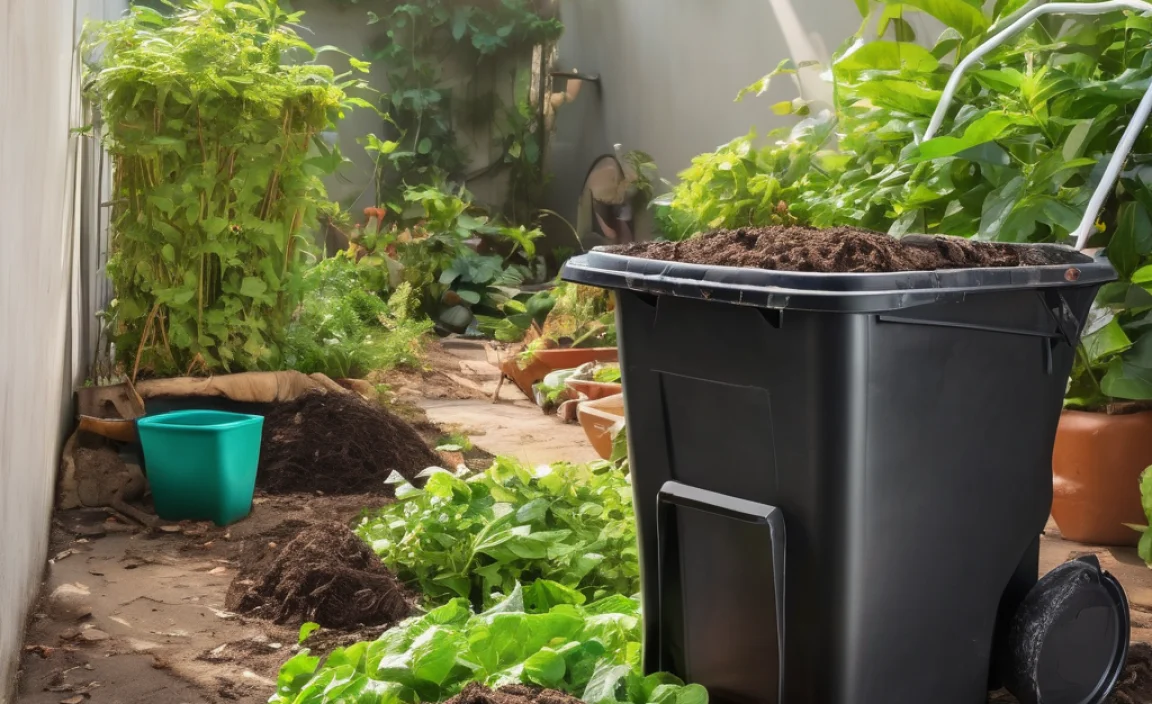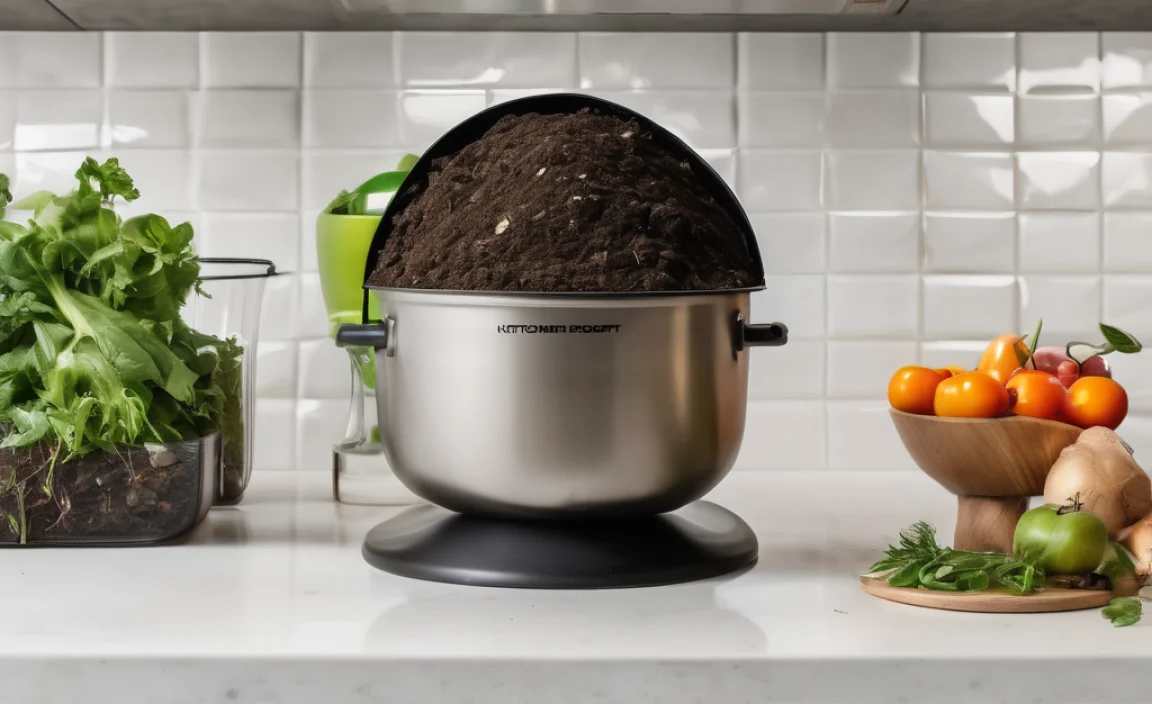Have you ever wondered what happens to food scraps after they make it to the compost bin? Indoor composting is a fun way to recycle kitchen waste. But did you know that the right temperature can speed things up? When composting indoors, keeping an eye on temperature is important. Too hot or too cold, and your compost might not work as well. Let’s dive into the world of composting and discover why this matters so much.
Key Takeaways
- Indoor composting needs a temperature between 55°F and 77°F.
- Too cold can slow composting down.
- The right temperature helps bacteria break down waste.
- Ventilation can help maintain proper indoor composting temperature.
- Check temperatures weekly for best results.
Understanding Indoor Composting Temperature
What is the best indoor composting temperature? Indoor composting works best between 55°F and 77°F. This is because bacteria that decompose the waste thrive in this range. If it gets too cold, bacteria slow down. They might even stop working altogether. When it’s too hot, the compost can dry out or smell bad. Keeping the right temperature helps everything break down quickly and without problems.
- Check the temperature with a thermometer.
- Adjust room conditions if needed.
- Keep compost moist, not wet.
- Cover the compost bin to retain heat.
- Turn the compost to mix and aerate.
Maintaining the ideal indoor composting temperature ensures your waste breaks down effectively. This process leads to rich compost that can feed plants. Good composting conditions also mean fewer odors and pests. So watch that thermometer and enjoy the transformation from scraps to soil!
Fun Fact or Stats : Bacteria generate heat as they work, which helps keep compost warm!
Why Temperature Matters
Temperature plays a huge role in composting. Why? Because the tiny organisms that break down the waste depend on it. Just like humans, these organisms have an ideal temperature range for working. If it’s too chilly, they get slow. If it’s too hot, they can die or stop working. This is why indoor composting temperature is key to a successful composting process.
How to Measure Compost Temperature
Measuring the temperature of your compost is easy! You can use a compost thermometer, which is long enough to reach the center of the pile. Insert it into the compost and wait for the reading. Aim for that magic range between 55°F and 77°F. If you notice the range is off, think about ways to adjust it, like moving your bin to a warmer spot or adding more material.
Ways to Adjust Indoor Composting Temperature
How can you keep your indoor compost at the right temperature? Start by placing your compost bin in a well-ventilated area. If it gets too cold, try wrapping the bin with a blanket or moving it to a warmer room. When it’s too hot, add some water to cool it down a bit. Always make sure the compost is not too wet or dry. Small adjustments can make a big difference!
Ideal Conditions for Indoor Composting
What else affects composting besides temperature? Besides the indoor composting temperature, moisture, air, and material mix are crucial. Moisture should be like a damp sponge. Too wet, and it becomes yucky. Too dry, and composting stops. Air helps prevent bad smells and keeps organisms happy. A good mix of greens and browns provides the right nutrition for bacteria.
- Moisture level should feel like a damp sponge.
- Ensure good airflow through the compost.
- Balance green and brown materials.
- Monitor for signs of pests or mold.
- Keep the bin out of direct sunlight.
These factors work together to create the perfect environment for composting. By balancing them, you ensure smooth and efficient composting. Keep an eye on each element, and you’ll produce rich compost in no time!
Fun Fact or Stats : Compost piles can reach up to 160°F outside! Indoors, we keep it cooler.
Balancing Greens and Browns
Do you know what greens and browns are? In composting, greens are things like vegetable scraps and coffee grounds. They provide nitrogen. Browns are materials like dry leaves or cardboard, which provide carbon. A good balance of both helps the compost break down nicely. If you have too many greens, the compost might smell bad. Too many browns, and it might slow down. Try a mix of about two parts browns to one part greens for the best results.
Importance of Moisture in Composting
Moisture in composting is like water to a plant. It keeps everything alive and working. But too much moisture can drown the good bacteria. Too little, and they dry up. The right moisture feels like a damp sponge. If it’s too wet, add some browns like paper. If it’s dry, sprinkle a little water. Checking moisture regularly helps keep your compost happy and productive.
Ventilation in Indoor Composting
Air is another key part of composting. It helps bacteria breathe and breaks down waste faster. Without air, compost can smell bad and slow down. Make sure your compost bin has some openings for air. Stirring the compost every week can also help. This mixes everything up and lets air in. With good airflow, your compost will stay fresh and decompose quickly.
Common Challenges in Indoor Composting
Indoor composting can face some challenges. Sometimes, you might notice bad smells. Other times, pests like fruit flies might appear. These issues often come from not following the indoor composting temperature or moisture rules. Too much or too little of anything can cause problems. But with a few simple changes, you can fix these issues quickly.
- Bad smells might mean not enough air.
- Fruit flies like exposed food scraps.
- Too wet compost can become smelly.
- Watch for signs of mold or pests.
- Temperature changes can slow composting.
By monitoring your compost and making small adjustments, you can keep these challenges at bay. Keep an eye on your compost and react quickly to changes. This way, you can enjoy a smooth composting experience indoors.
Fun Fact or Stats : Fruit flies can lay up to 500 eggs at once, so cover food scraps!
Dealing with Pests
No one likes pests in their compost bin. But sometimes they show up. Fruit flies and other bugs like scraps exposed to air. Cover your food scraps with browns, like paper or leaves. This keeps pests away. If pests show up, try to find where they’re coming from. Make sure your bin is closed tightly. With a little care, you can keep pests out of your compost.
Troubleshooting Odors
What to do if your compost smells bad? Start by checking the moisture and airflow. Too much moisture and not enough air are common problems. Make sure the bin has holes for air to circulate. Stirring the compost helps, too. Sometimes adding more browns, like dry leaves, can soak up excess moisture and reduce smell. Fixing these can make your compost smell fresh again.
Preventing Mold in Compost
Mold can sometimes grow in compost. It’s usually a sign of too much moisture or not enough air. To prevent mold, check the moisture regularly. Make sure it’s like a damp sponge, not soaking wet. Stir the compost often to let air in. Add more browns if it’s too wet. If mold appears, remove the affected parts. These steps help keep your compost healthy and mold-free.
Maintaining Composting Efficiency
How can you keep your compost working well? Regular maintenance is key. Check the indoor composting temperature, moisture, and air weekly. Make adjustments if something seems off. Keep a balance of greens and browns in your bin. And don’t overfill it. Too much material can slow down the process. By staying on top of these details, you’ll have efficient composting.
- Monitor temperature weekly for best results.
- Keep moisture levels like a damp sponge.
- Ensure good airflow in the bin.
- Balance greens and browns properly.
- Turn compost every week to mix.
With regular care and attention, your compost will thrive. You’ll produce rich, nutrient-filled compost to feed your plants. And you’ll enjoy the process of turning waste into soil. So keep checking and adjusting, and watch your compost grow!
Fun Fact or Stats : Properly maintained compost can be ready in as little as two months!
Daily Composting Habits
Want to make composting a part of your life? Start with daily habits. Collect kitchen scraps in a small container. Empty it into the compost bin each day. Check the bin’s moisture and temperature weekly. Stir the compost every few days for better results. These small tasks can make a big difference. They help keep your compost healthy and efficient. With regular attention, you’ll soon see the fruits of your labor turn into rich soil.
Weekly Compost Check-Up
Checking your compost weekly helps keep it working well. Look at the moisture and temperature. Adjust them if needed. Make sure the bin has enough air. Stir the compost to mix everything up. These checks prevent problems and keep your compost on track. With consistent care, you’ll create nutrient-rich soil for your plants.
Importance of Turning Compost
Turning your compost is like giving it a breath of fresh air. It helps mix the materials and lets air in. This speeds up the composting process. Turning also prevents bad smells and stops pests from settling in. Try to turn your compost every week. If it’s too heavy, ask someone to help. Regular turning makes your compost healthy and productive.
Conclusion
Indoor composting is a rewarding activity when done right. The indoor composting temperature plays a key role in this process. With the right temperature, moisture, and air, you can create rich compost. Regular checks and adjustments ensure your compost thrives. Happy composting!
FAQs
Question: What is the best indoor composting temperature?
Answer: The best indoor composting temperature is between 55°F and 77°F. This range helps bacteria break down waste efficiently. If the temperature is too high or low, composting may slow down or stop.
Question: Why is temperature important in composting?
Answer: Temperature is crucial because it affects bacteria activity. Bacteria need a certain warmth to work effectively. Too cool, and they slow down. Too hot, and they might die. Keeping the right temperature helps your compost process smoothly.
Question: How can I measure compost temperature?
Answer: Use a compost thermometer to measure the temperature. Insert it into the center of the compost pile. The reading should be between 55°F and 77°F. This check ensures your compost is in the optimal range for breaking down materials.
Question: How do I adjust the temperature of my compost?
Answer: Move the compost bin to a warmer location if it’s too cold. If it’s too hot, add water or move it to a cooler spot. Covering the bin can help retain heat. Always monitor to keep the temperature in the ideal range.
Question: What happens if my compost is too wet?
Answer: If your compost is too wet, it can become smelly and slow down the composting process. Add more brown materials like dry leaves or shredded paper to soak up excess moisture. Make sure there’s good airflow to help dry it out.
Question: Can I compost in any weather?
Answer: Yes, you can compost in any weather, but indoor composting is more stable. Inside, you can control the temperature and conditions better, which helps keep the composting process going all year round.


